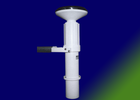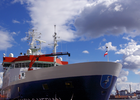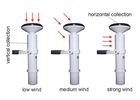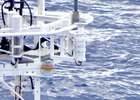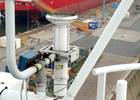Ship rain gauge SRM 450
Special rain gauge for application at high wind speeds
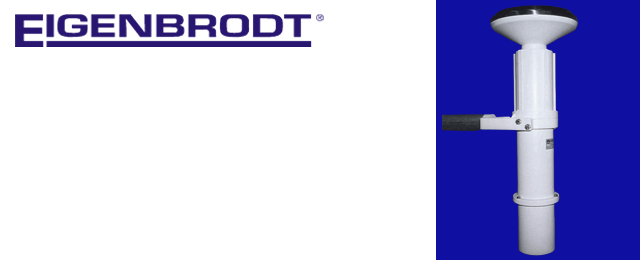
Benefits
- Designed operation on buoys and shipboard
- High quality precipitation measurement including lateral precipitation, also with high wind speeds
- Suitable for long-term operation
Description
PRINCIPLE OF MEASUREMENT
The ship rain gauge is designed to measure rain fall on moving ships or buoys. The high relative flow velocities on a cruising vessel may carry the rain almost horizontally over the ship. By measuring the amount of water that is collected by a vertical surface, a correction for the wind effect is possible. Evidently the local relative wind speed at the monitoring site of the instrument is to be measured simultaneously.
Rain is collected at the horizontal orifice and at the vertical collector. There are five vertical T-bars at the circumference of the vertical collector that hinders rain water to wander around the cylinder and to be blown off in lee.
TECHNICAL REALISATION
This special design features a horizontal orifice of a conventional rain gauge and a vertical collecting surface. The water amount from both surfaces is collected separately, and measured by forming and counting drops of calibrated size. The aerodynamic “champagne-cup” shape of the instrument was designed to reduce the under catch resulting from flow distortion by the gauge itself.
THEORY
The horizontal orifice measures rainfall like any land based conventional rain gauge. The vertical collecting surface measures liquid water content in the volume of air defined from the cross-section of the gauge and the relative wind speed. From the liquid water content of the air, the rainfall rate can be estimated by assuming a raindrop size distribution. From the information of the two collecting surfaces, considering local flow velocity, an empirical calibration of the instrument is to be done.
SITING
The measurement of the liquid water content is independent of local up- or downdrafts. The catch by the horizontal orifice can be influenced by local up-/or downdrafts, depending on the drop-size distribution. This requires to place the instrument high up above the superstructure of the ship in order to minimize influence of local ship induced velocities. In order to deal with ship roll motions in a sea state, the instrument shall be suspended to swing freely around an axis parallel to the ships long axis. The instrument has been tested against an optical disdrometer during several cruises at research vessels and since 1991 is routinely operated at RV Meteor or RV Polarstern for example.
RECORDING
The instrument output provides counts of calibrated drops from the top and from the side. Typically, these are to be recorded together with the counts of a cup anemometer (and auxiliary data like date, time, ship position) on PC. Basic recommended recording time unit is two minutes. For this time, rainfall rates are calculated for the top and the side separately and a corrected rain fall rate is obtained as a wind speed dependent weighted average.
HEATING
The SRM 450 is available as a heated version and as a extra heated version. The built in heating is meant to prevent the inside electronics and drain from freezing. Certain heating capacity is also supplied to the collection funnel as well as to the vertical collection area melting down snow and hail. Never the less the heating is limited to certain chilling effects on moving vessels combined with freezing temperatures.
Scope of delivery
- 2 drop-counter measuring system (one for vertical portion and one for lateral portion of precipitation)
- Digital output for each counter (raw counter signal)
- Algorithm to calculate actual rain-rates (wind speed data needed)
- Sea-proof housing
Options
- Heating / extended heating
- 3 dropper version to handle higher vertical rain-rates
- Serial output, including calculation of rain rates (when external wind speed input is available)
- Suspension (semi gimble / gimble)

 Deutsch
Deutsch English
English